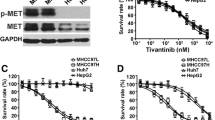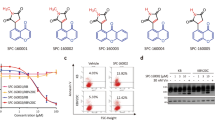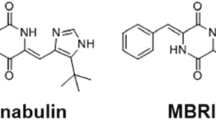Abstract
Purpose
The anti-mitotic agent, combretastatin A-4 (CA-4), is the lead compound of a new class of anti-cancer drugs that target tumor vasculature. 2-Methoxy-5-(2-(3, 4, 5-trimethoxyphenyl) thiophen-3-yl) aniline (DAT-230) is a structurally novel CA-4 analog with more stability. We investigated its anti-tumor activity and mechanisms in vitro and in vivo for the first time.
Methods
Cytotoxicity was measured by MTT method. Apoptosis, mitochondria membrane potential (ΔΨm) and NO generation were measured by flow cytometry. Intracellular microtubule network was detected by immunofluorescence experiments. Protein expression was analyzed by Western blotting. In vivo, the anti-tumor activity was assessed using fibrosarcoma xenografts subcutaneously established in BALB/c nude mice. Vasculature perfusion was identified using fluorescent DNA-binding compound Hoechst 33342.
Results
DAT-230 exhibited potent anti-proliferative activity against various cancer cells. DAT-230-treatment in HT-1080 cells resulted in microtubule de-polymerization and G2/M phase arrest preceding apoptosis. Phosphor-cdc2 (thr14/tyr15) reduction, cyclin B1 accumulation and aberrant spindles denoted the cyclin B1-cdc2 complex active and M phase arrest in HT-1080 cells treated with DAT-230. Apoptosis induced by DAT-230 was related with the activation of caspase-9, caspase-3 and PARP cleavage, which were at the downstream of mitochondria. The decrease ratio of Bcl-2/Bax, elevation of NO and disruption of ΔΨm confirmed the causal relationship between DAT-230 and mitochondrial pathway. In vivo, DAT-230 delayed tumor growth, induced tumor perfusion decrease and extensive hemorrhagic-necrosis.
Conclusions
DAT-230 is a promising microtubule inhibitor that has great potential for the treatment of fibrosarcoma in vitro and in vivo. Its potential to be a candidate of anti-cancer agent is worth being further investigated.






Similar content being viewed by others
Abbreviations
- CA-4:
-
Combretastatin A-4
- DAT-230:
-
2-methoxy-5-(2-(3, 4, 5-trimethoxyphenyl) thiophen-3-yl) aniline
- ΔΨm:
-
Mitochondria membrane potential
- Rh123:
-
Rhodamine-123
- NO:
-
Nitric oxide
- SNP:
-
Sodium nitroprusside dihydrate
References
Wu R, Ding W, Liu T, Zhu H, Hu Y, Yang B, He Q (2009) XN05, a novel synthesized microtubule inhibitor, exhibits potent activity against human carcinoma cells in vitro. Cancer Lett 285(1):13–22
Baguley BC, Holdaway KM, Thomsen LL, Zhuang L, Zwi LJ (1991) Inhibition of growth of colon 38 adenocarcinoma by vinblastine and colchicine: evidence for a vascular mechanism. Eur J Cancer 27(4):482–487
Hill SA, Lonergan SJ, Denekamp J, Chaplin DJ (1993) Vinca alkaloids: anti-vascular effects in a murine tumour. Eur J Cancer 29A(9):1320–1324
Nihei Y, Suzuki M, Okano A, Tsuji T, Akiyama Y, Tsuruo T, Saito S, Hori K, Sato Y (1999) Evaluation of antivascular and antimitotic effects of tubulin binding agents in solid tumor therapy. Jpn J Cancer Res 90(12):1387–1395
Woods JA, Hadfield JA, Pettit GR, Fox BW, McGown AT (1995) The interaction with tubulin of a series of stilbenes based on combretastatin A-4. Br J Cancer 71(4):705–711
Grosios K, Holwell SE, Mc AT, Pettit GR, Bibby MC (1999) In vivo and in vitro evaluation of combretastatin A-4 and its sodium phosphate prodrug. Br J Cancer 81(8):1318–1327
Blakey DC, Westwood FR, Walker M, Hughes GD, Davis PD, Ashton SE, Ryan AJ (2002) Antitumor activity of the novel vascular targeting agent ZD6126 in a panel of tumor models. Clin Cancer Res 8(6):1974–1983
Griggs J, Metcalfe JC, Hesketh R (2001) Targeting tumour vasculature: the development of combretastatin A4. Lancet Oncol 2(2):82–87
Chaplin DJ, Dougherty GJ (1999) Tumour vasculature as a target for cancer therapy. Br J Cancer 80(Suppl 1):57–64
Otani M, Natsume T, Watanabe JI, Kobayashi M, Murakoshi M, Mikami T, Nakayama T (2000) TZT-1027, an antimicrotubule agent, attacks tumor vasculature and induces tumor cell death. Jpn J Cancer Res 91(8):837–844
Nam NH (2003) Combretastatin A-4 analogues as antimitotic antitumor agents. Curr Med Chem 10(17):1697–1722
Kanthou C, Tozer GM (2009) Microtubule depolymerizing vascular disrupting agents: novel therapeutic agents for oncology and other pathologies. Int J Exp Pathol 90(3):284–294
Marrelli M, Conforti F, Statti GA, Cachet X, Michel S, Tillequin F, Menichini F (2011) Biological potential and structure-activity relationships of most recently developed vascular disrupting agents: an overview of new derivatives of natural combretastatin a-4. Curr Med Chem 18(20):3035–3081
Liou JP, Hsu KS, Kuo CC, Chang CY, Chang JY (2007) A novel oral indoline-sulfonamide agent, N-[1-(4-methoxybenzenesulfonyl)-2,3-dihydro-1H-indol-7-yl]-isonicotinamide (J30), exhibits potent activity against human cancer cells in vitro and in vivo through the disruption of microtubule. J Pharmacol Exp Ther 323(1):398–405
Blagosklonny MV, Schulte TW, Nguyen P, Mimnaugh EG, Trepel J, Neckers L (1995) Taxol induction of p21WAF1 and p53 requires c-raf-1. Cancer Res 55(20):4623–4626
Zhu H, Zhang J, Xue N, Hu Y, Yang B, He Q (2010) Novel combretastatin A-4 derivative XN0502 induces cell cycle arrest and apoptosis in A549 cells. Invest New Drugs 28(4):493–501
Saris NE, Teplova VV, Odinokova IV, Azarashvily TS (2004) Interference of calmidazolium with measurement of mitochondrial membrane potential using the tetraphenylphosphonium electrode or the fluorescent probe rhodamine 123. Anal Biochem 328(2):109–112
Mikirova NA, Ichim TE, Riordan NH (2008) Anti-angiogenic effect of high doses of ascorbic acid. J Transl Med 6:50. doi:1479-5876-6-50
Dalal S, Burchill SA (2009) Preclinical evaluation of vascular-disrupting agents in Ewing’s sarcoma family of tumours. Eur J Cancer 45(4):713–722
Homesley HD, Filiaci V, Gibbons SK, Long HJ, Cella D, Spirtos NM, Morris RT, DeGeest K, Lee R, Montag A (2009) A randomized phase III trial in advanced endometrial carcinoma of surgery and volume directed radiation followed by cisplatin and doxorubicin with or without paclitaxel: a Gynecologic Oncology Group study. Gynecol Oncol 112(3):543–552
King KL, Cidlowski JA (1995) Cell cycle and apoptosis: common pathways to life and death. J Cell Biochem 58(2):175–180
Toyoshima F, Moriguchi T, Wada A, Fukuda M, Nishida E (1998) Nuclear export of cyclin B1 and its possible role in the DNA damage-induced G2 checkpoint. EMBO J 17(10):2728–2735
Meijer L, Azzi L, Wang JY (1991) Cyclin B targets p34cdc2 for tyrosine phosphorylation. EMBO J 10(6):1545–1554
Suen DF, Norris KL, Youle RJ (2008) Mitochondrial dynamics and apoptosis. Genes Dev 22(12):1577–1590
Smith KA, Hill SA, Begg AC, Denekamp J (1988) Validation of the fluorescent dye Hoechst 33342 as a vascular space marker in tumours. Br J Cancer 57(3):247–253
Papagelopoulos PJ, Galanis EC, Trantafyllidis P, Boscainos PJ, Sim FH, Unni KK (2002) Clinicopathologic features, diagnosis, and treatment of fibrosarcoma of bone. Am J Orthop (Belle Mead NJ) 31(5):253–257
Collin CF, Friedrich C, Godbold J, Hajdu S, Brennan MF (1988) Prognostic factors for local recurrence and survival in patients with localized extremity soft-tissue sarcoma. Semin Surg Oncol 4(1):30–37
Weitz J, Antonescu CR, Brennan MF (2003) Localized extremity soft tissue sarcoma: improved knowledge with unchanged survival over time. J Clin Oncol 21(14):2719–2725
Cenciarelli C, Tanzarella C, Vitale I, Pisano C, Crateri P, Meschini S, Arancia G, Antoccia A (2008) The tubulin-depolymerising agent combretastatin-4 induces ectopic aster assembly and mitotic catastrophe in lung cancer cells H460. Apoptosis 13(5):659–669
Doree M, Galas S (1994) The cyclin-dependent protein kinases and the control of cell division. FASEB J 8(14):1114–1121
Porter LA, Donoghue DJ (2003) Cyclin B1 and CDK1: nuclear localization and upstream regulators. Prog Cell Cycle Res 5:335–347
Nabha SM, Mohammad RM, Dandashi MH, Coupaye-Gerard B, Aboukameel A, Pettit GR, Al-Katib AM (2002) Combretastatin-A4 prodrug induces mitotic catastrophe in chronic lymphocytic leukemia cell line independent of caspase activation and poly(ADP-ribose) polymerase cleavage. Clin Cancer Res 8(8):2735–2741
Nicholson DW (2000) From bench to clinic with apoptosis-based therapeutic agents. Nature 407(6805):810–816
Desagher S, Martinou JC (2000) Mitochondria as the central control point of apoptosis. Trends Cell Biol 10(9):369–377
Ryan L, O’Callaghan YC, O’Brien NM (2005) The role of the mitochondria in apoptosis induced by 7beta-hydroxycholesterol and cholesterol-5beta,6beta-epoxide. Br J Nutr 94(4):519–525
Muto Y, Moriwaki H, Ninomiya M, Adachi S, Saito A, Takasaki KT, Tanaka T, Tsurumi K, Okuno M, Tomita E, Nakamura T, Kojima T (1996) Prevention of second primary tumors by an acyclic retinoid, polyprenoic acid, in patients with hepatocellular carcinoma. Hepatoma Prevention Study Group. N Engl J Med 334(24):1561–1567
Holmes WF, Soprano DR, Soprano KJ (2003) Early events in the induction of apoptosis in ovarian carcinoma cells by CD437: activation of the p38 MAP kinase signal pathway. Oncogene 22:6377–6386
Mendez G, Policarpi C, Cenciarelli C, Tanzarella C, Antoccia A (2011) Role of Bim in apoptosis induced in H460 lung tumor cells by the spindle poison Combretastatin-A4. Apoptosis 16:940–949
Mollinedo F, Gajate C (2003) Microtubules, microtubule-interfering agents and apoptosis. Apoptosis 8:413–450
Dark GG, Hill SA, Prise VE, Tozer GM, Pettit GR, Chaplin DJ (1997) Combretastatin A-4, an agent that displays potent and selective toxicity toward tumor vasculature. Cancer Res 57(10):1829–1834
Tozer GM, Prise VE, Wilson J, Locke RJ, Vojnovic B, Stratford MR, Dennis MF, Chaplin DJ (1999) Combretastatin A-4 phosphate as a tumor vascular-targeting agent: early effects in tumors and normal tissues. Cancer Res 59(7):1626–1634
Siemann DW, Chaplin DJ, Walicke PA (2009) A review and update of the current status of the vasculature-disabling agent combretastatin-A4 phosphate (CA-4P). Expert Opin Investig Drugs 18(2):189–197
Wehbe H, Kearney CM, Pinney KG (2005) Combretastatin A-4 resistance in H460 human lung carcinoma demonstrates distinctive alterations in beta-tubulin isotype expression. Anticancer Res 25:3865–3870
Quan H, Liu H, Li C, Lou L (2009) 1,4-Diamino-2,3-dicyano-1,4-bis (methylthio) butadiene (U0126) enhances the cytotoxicity of combretastatin A4 independently of mitogen-activated protein kinase kinase. J Pharmacol Exp Ther 330:326–333
Acknowledgments
The authors would like to acknowledge Ms. Mu for her technical assistance. This work was supported by National S&T Major Project (2009 ZX 09301) and National Natural Science Foundation of China (Grant No. 30973614).
Conflict of interest
None.
Author information
Authors and Affiliations
Corresponding authors
Electronic supplementary material
Below is the link to the electronic supplementary material.
Rights and permissions
About this article
Cite this article
Qiao, F., Zuo, D., Shen, X. et al. DAT-230, a novel microtubule inhibitor, exhibits potent anti-tumor activity by inducing G2/M phase arrest, apoptosis in vitro and perfusion decrease in vivo to HT-1080. Cancer Chemother Pharmacol 70, 259–270 (2012). https://doi.org/10.1007/s00280-012-1907-x
Received:
Accepted:
Published:
Issue Date:
DOI: https://doi.org/10.1007/s00280-012-1907-x




